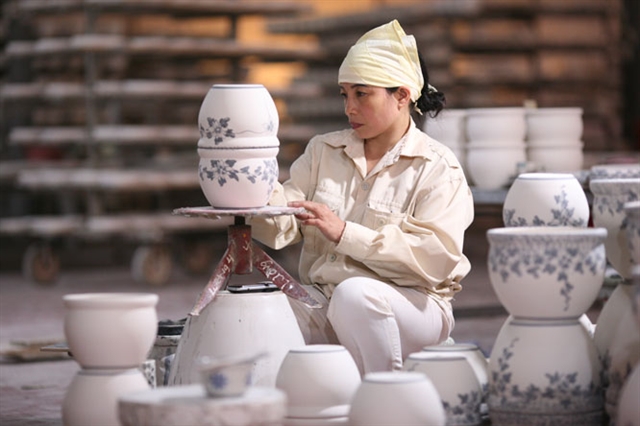 Society
Society

Traditional craft villages in Hà Nội have been pulling out all the stops to survive and indeed thrive amid the COVID-19 pandemic.

|
| A worker in Bát Tràng Ceramic Village. — Photo hanoimoi.vn |
HÀ NỘI —Traditional craft villages in Hà Nội have been pulling out all the stops to survive and indeed thrive amid the COVID-19 pandemic.
The villages have adapted their products to suit consumers' tastes, used innovative technology, diversified product displays and expanded their markets through e-commerce channels.
Hà Nội has 1,350 traditional craft villages focusing on traditional crafts like lacquer, mosaic, embroidery, silk weaving, ceramics, bamboo and rattan weaving.
Companies, co-operatives and household businesses in the villages provide jobs for more than 739,000 people.
According to Hà Thị Vinh, chairwoman of the Hà Nội Association of Handicrafts and Traditional Craft Villages, the city is home to the largest number of craft villages and artisans in the country.
Craft villages have helped develop related services such as raw material production, transportation and food service and generated jobs for workers amid urbanisation, Vinh said.
In the past five years, the city has helped develop 16 technical demonstration models at enterprises and technological renovation in 60 business establishments.
As a result, labour productivity has increased, costs have been cut and pollution reduced. For example, in the ceramic village of Bát Tràng Commune, the coal furnaces have been replaced by gas furnaces while in Kiêu Kỵ Commune, specialised machines have been used for leather sewing.
Craft villages have been provided with support to design handicraft products suited for the export and domestic markets, as well as offered vocational training programmes on business administration skills and policies related to craft villages.
“As a result of the above programmes, businesses and households have gained many skills and ideas to produce many new fashionable product lines suitable to the tastes of export and domestic markets to sell the products the market needs, not the products we have,” said Vinh.
Challenges
The biggest challenge craft villages face is that artisans and skilled workers account for just 30 per cent of their workforces due to the small-scale nature of their businesses.
In addition, handicraft production requires meticulousness, creativity, aesthetics and economic value so workers need a great deal of meticulous training that puts a lot of people off the career path, Vinh said.
Craft village enterprises also face tough competition with similar products from other countries in the region, high costs and the need to constantly change product designs to meet market requirements.
It is also difficult to expand production areas to create the room to apply science, technology and advanced equipment.
Most handicraft establishments are still small or micro-sized with outdated equipment and technology, while product quality has not met the requirements of the domestic market, let alone export ones.
Another problem is connecting craft villages with each other, as well as wholesale and retail centres.
There is a lack of established centres to display and introduce the products of craft villages so marketing work still faces many difficulties.
E-commerce opportunity
To develop handicraft production, State management agencies could build an official e-commerce website for craft villages to market their products and hold domestic and international trade fairs to help businesses get involved with trading chains, suppliers and distributors, according to Đỗ Trọng Đoàn, an artisan of Hạ Thái Lacquer Village.
Phạm Khắc Hà, chairman of Vạn Phúc Silk Weaving Village Association, said with the consumption market being affected by the COVID-19 pandemic, many businesses and production facilities have put their products on e-commerce websites with success.
To sustainably develop the craft villages, it was necessary to solve the problem of distribution, Hà said.
The assistance from authorities at all levels was very important through preferential policies to create conditions for craft villages to develop, especially in the post-COVID-19 period, he said.
According to Vinh, to sustainably develop craft villages, vocational training establishments should focus on training machine-based product design and professional skills for each product line. Authorities could organise a competition to design tourism gifts to select products that meet the needs of the market, she added. — VNS